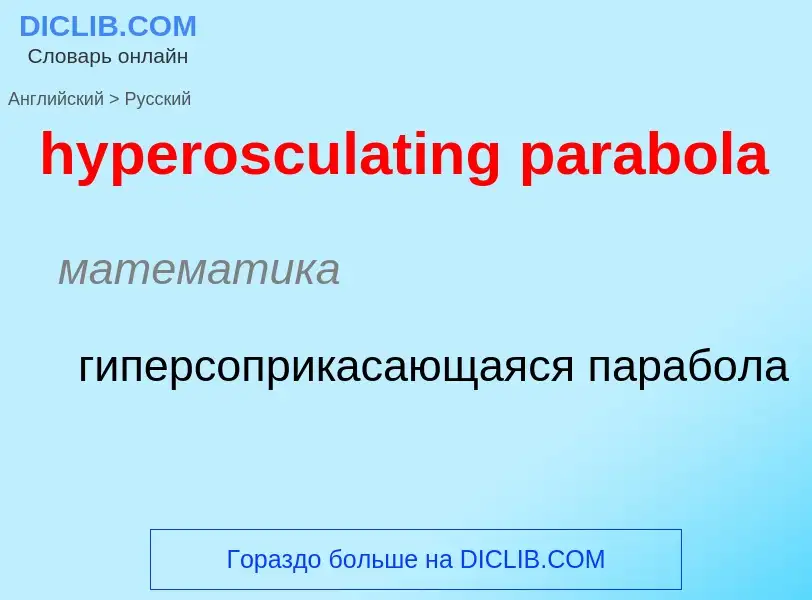Μετάφραση και ανάλυση λέξεων από τεχνητή νοημοσύνη
Σε αυτήν τη σελίδα μπορείτε να λάβετε μια λεπτομερή ανάλυση μιας λέξης ή μιας φράσης, η οποία δημιουργήθηκε χρησιμοποιώντας το ChatGPT, την καλύτερη τεχνολογία τεχνητής νοημοσύνης μέχρι σήμερα:
- πώς χρησιμοποιείται η λέξη
- συχνότητα χρήσης
- χρησιμοποιείται πιο συχνά στον προφορικό ή γραπτό λόγο
- επιλογές μετάφρασης λέξεων
- παραδείγματα χρήσης (πολλές φράσεις με μετάφραση)
- ετυμολογία
hyperosculating parabola - translation to ρωσικά
математика
гиперсоприкасающаяся парабола
общая лексика
полукубическая парабола
[pə'ræbələ]
общая лексика
парабола
существительное
математика
парабола
Ορισμός
Βικιπαίδεια
In mathematics, a cuspidal cubic or semicubical parabola is an algebraic plane curve that has an implicit equation of the form
(with a ≠ 0) in some Cartesian coordinate system.
Solving for y leads to the explicit form
which imply that every real point satisfies x ≥ 0. The exponent explains the term semicubical parabola. (A parabola can be described by the equation y = ax2.)
Solving the implicit equation for x yields a second explicit form
The parametric equation
can also be deduced from the implicit equation by putting
The semicubical parabolas have a cuspidal singularity; hence the name of cuspidal cubic.
The arc length of the curve was calculated by the English mathematician William Neile and published in 1657 (see section History).








![A [[bouncing ball]] captured with a stroboscopic flash at 25 images per second. The ball becomes significantly non-spherical after each bounce, especially after the first. That, along with spin and [[air resistance]], causes the curve swept out to deviate slightly from the expected perfect parabola. A [[bouncing ball]] captured with a stroboscopic flash at 25 images per second. The ball becomes significantly non-spherical after each bounce, especially after the first. That, along with spin and [[air resistance]], causes the curve swept out to deviate slightly from the expected perfect parabola.](https://commons.wikimedia.org/wiki/Special:FilePath/Bouncing ball strobe edit.jpg?width=200)

![The supporting cables of [[suspension bridge]]s follow a curve that is intermediate between a parabola and a [[catenary]]. The supporting cables of [[suspension bridge]]s follow a curve that is intermediate between a parabola and a [[catenary]].](https://commons.wikimedia.org/wiki/Special:FilePath/Laxmanjhula.jpg?width=200)
![Rainbow Bridge]] across the [[Niagara River]], connecting [[Canada]] (left) to the [[United States]] (right). The parabolic arch is in compression and carries the weight of the road. Rainbow Bridge]] across the [[Niagara River]], connecting [[Canada]] (left) to the [[United States]] (right). The parabolic arch is in compression and carries the weight of the road.](https://commons.wikimedia.org/wiki/Special:FilePath/Rainbow Bridge(2).jpg?width=200)
![Parabolic shape formed by a liquid surface under rotation. Two liquids of different densities completely fill a narrow space between two sheets of transparent plastic. The gap between the sheets is closed at the bottom, sides and top. The whole assembly is rotating around a vertical axis passing through the centre. (See [[Rotating furnace]]) Parabolic shape formed by a liquid surface under rotation. Two liquids of different densities completely fill a narrow space between two sheets of transparent plastic. The gap between the sheets is closed at the bottom, sides and top. The whole assembly is rotating around a vertical axis passing through the centre. (See [[Rotating furnace]])](https://commons.wikimedia.org/wiki/Special:FilePath/Parabola shape in rotating layers of fluid.jpg?width=200)
![[[Solar cooker]] with [[parabolic reflector]] [[Solar cooker]] with [[parabolic reflector]]](https://commons.wikimedia.org/wiki/Special:FilePath/ALSOL.jpg?width=200)
![[[Parabolic microphone]] with optically transparent plastic reflector used at an American college football game. [[Parabolic microphone]] with optically transparent plastic reflector used at an American college football game.](https://commons.wikimedia.org/wiki/Special:FilePath/ParabolicMicrophone.jpg?width=200)
![Array of [[parabolic trough]]s to collect [[solar energy]] Array of [[parabolic trough]]s to collect [[solar energy]]](https://commons.wikimedia.org/wiki/Special:FilePath/Solar Array.jpg?width=200)
![Edison]]'s searchlight, mounted on a cart. The light had a parabolic reflector. Edison]]'s searchlight, mounted on a cart. The light had a parabolic reflector.](https://commons.wikimedia.org/wiki/Special:FilePath/Ed d21m.jpg?width=200)
![Physicist [[Stephen Hawking]] in an aircraft flying a parabolic trajectory to simulate zero gravity Physicist [[Stephen Hawking]] in an aircraft flying a parabolic trajectory to simulate zero gravity](https://commons.wikimedia.org/wiki/Special:FilePath/Physicist Stephen Hawking in Zero Gravity NASA.jpg?width=200)
